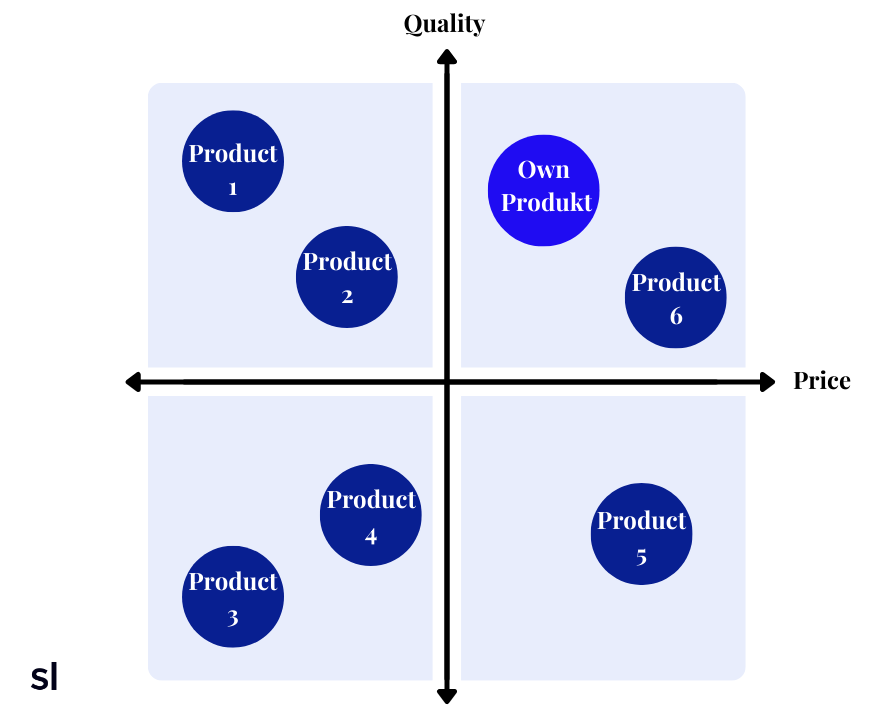
Brand Positioning: Stand Out in the Market!
Last update: 11 April 2023 at 09:26 am
It can be quite difficult for companies to stand out with their brand in a crowded market – especially when there are numerous competitors and rivals who have established themselves in the same product segment.
To get more visibility here and stand out from the crowd with your service and marketing, good branding, and brand positioning is essential.
In this article, you will learn how to achieve successful and sustainable brand positioning.
What Is Brand Positioning?
Brand positioning is the way a brand is perceived in the minds of customers. In a brand positioning strategy, the goal here is to create a distinct brand identity and become more attractive to your customers, stand out from your competitors, and create a brand identity that your target market will remember.
But what makes brand positioning important?
Brand positioning is a very important part of your marketing and sales efforts because it allows you to advertise more effectively, market your products better, and sustainably use your resources more efficiently.
Having your own brand positioning strategy also helps you clearly define what makes your brand different from others. In the long run, this can not only lead to higher sales for your company but also help you become a brand leader in your industry.
What Are the Benefits of Brand Positioning?
The benefits of successful brand positioning for your business are numerous. For example, successful positioning allows you to dominate your market, improve profit margins, and reduce your risks.
Other benefits of strong brand positioning include:
- Increasing sales
- Increasing market share for your brands
- Increasing customer brand loyalty
- Increasing awareness of your brands
- Improvement of brand reputation
- Increase in brand equity
Increasing sales
Sales growth is when more people buy your product or service than before. Increased sales can be measured by market share, demand for products and/or services, profitability, and other factors.
If you position yourself successfully in a segment with your brand, this can lead to more customers. They, in turn, buy more products, which, in turn, ultimately leads to increased revenue for your company.
Increasing market share for your brands
Market share refers to the percentage of total sales that your brand controls.
If you establish your brands successfully and hold your own against the competition, in the long term, this can lead to an increase in your place on the market, i.e. you take customers and sales away from your competitors thanks to well-thought-out positioning.
This in turn increases your market share – and at best leads to brand leadership in your market.
Increase customer brand loyalty
One of the most important things your marketing efforts can accomplish is generating loyal customers. This can be a challenge, as many brands vie with each other and with new companies for customers’ attention and loyalty.
But customer loyalty is extremely important because it leads to more sales, which in turn leads to profit, which brings future growth and higher brand value.
If you position yourself successfully with your product or service and repeatedly deliver on your brand promise, you can positively influence your customers’ loyalty, and you will thus build a loyal customer base.
Increase brand awareness
Brand awareness is the first step in building a successful brand. Especially when you launch a new product, you need to make sure that customers are aware of your company’s offering and engage with it.
Appropriate brand positioning can help increase awareness of your company among your target customers.
Improve brand reputation
How your brand is perceived, i.e. what image or reputation it has among customers, has an immense impact on who buys your products.
If your brand is perceived as rather negative or even overpriced, for example, it is less likely to be purchased than if your brand has a very positive image among customers.
How Can I Position My Brand?
Brand positioning is about defining the image you want your brand to convey. You need to determine how people perceive your company, product, or service and what emotions you associate with it.
It’s important to ask yourself the following questions when defining a brand positioning:
- What do I want to achieve with my brand?
- What do I want customers to think about my brand?
- Who is my target group?
- Who are my competitors?
- How do I differentiate myself from other brands?
- What should my brand look like?
Answering all these questions and successfully positioning your brand as desired is a major challenge. Therefore, do not shy away from getting the support of a professional branding agency. There are also agencies that specialize explicitly in brand positioning and that can help you create a strong brand positioning statement.
Step 1: Define the goal of your brand
The first step in developing a strong brand is to define what your brand wants to be and why it exists.
This can be difficult because most companies have a hard time explaining what they do, but with proper planning and research, you can create compelling messages that resonate with potential customers.
Step 2: Capture your brand values
Brand values are the emotional aspects of your brand. They are what your brand stands for, and they are the sum total of everything people think and feel about your brand.

They can be used to define the core qualities of a product or service, helping it stand out from competitors’ offerings.
Apple products, for example, are considered innovative and elegant; their design has inspired many imitators over the years. Another value could be sustainability and responsible use of resources.
No matter which values you choose, they should always be reflected in the content of your brand and in the information and ads, you present to the outside world.
Step 3: Determine your target audiences
Defining your target audience is about identifying what a potential customer’s needs are and where a customer goes. Once you understand what makes your target audience tick, you can provide appropriate solutions for them and target their preferences with your brand values.
Many brands resort to so-called personas when determining your ideal customer. This is an exercise between employees from different departments of a company to leverage their respective expertise and define one or more customer profiles that will help with positioning.
To define a persona, you should gather as much information about the customer as possible. This includes demographic characteristics such as place of residence, age, and gender, but also other aspects such as which platform the customer uses and which trends can be identified in the use of products.
Step 4: Conduct a competitor analysis
Competitor analysis is a process that allows you to learn about your competitors’ strengths and weaknesses so that you can develop a unique and compelling value proposition for yourself.
It helps you understand your competitors’ brand positioning and what makes them good or bad from an advertising perspective.

You should also look at data on pricing structures, sales channels (e.g., via a digital platform or brick-and-mortar), and customer service as well.
This information will help you determine how best to position yourself against these existing brands for maximum consumer visibility.
Step 5: Determine your unique selling proposition.
To position your brand with appropriate success, you should stand out from other brands with a unique selling proposition, or USP. Basically, the so-called positioning cross serves as a basis for the development of an appropriate marketing strategy.
By presenting your strategy in this way, you can quickly identify which position makes sense for your company and which USP promises the most success.
The positioning cross – How it works
The best way to start with the positioning cross is with a product for which your brand is particularly popular or well-known among your customers – or with which you would like to establish yourself on the market in the long term.
Next, draw a diagram in which you contrast opposing information about your products or services. The classic here is price vs. quality, for example, but other content, such as sustainability or exclusivity, can also form the basis here.

Next, mark other companies along the axes in the diagram with which you are in direct competition. Now you only have to position your own product within the drawn matrix.

This simplified visualization can quickly help you define your marketing strategies and ultimately your company’s brand positioning.
Step 6: Define your brand image
Finally, it’s time to visually define your brand. This includes all the essentials of what a customer will perceive about your company – from their logo and color scheme to their product design, website layout, and social media presence.
To summarize
A brand’s effectiveness depends on how well it can convey a message about itself – whether it has one overarching vision or several distinct personalities.
The key to defining your brand is to understand what you want it to stand for in the minds of consumers. Once you have a clear idea of what your brand stands for, you can begin to communicate that vision through every aspect of marketing: from ongoing advertising campaigns to product packaging design, newsletters and blog content, a dedicated magazine for customers or other resources to showcase your business.
Examples of Good Brand Positioning Strategy
A good brand positioning manages to communicate the brand image in a clear and convincing message to the pre-defined target group and thus successfully differentiate itself from competitors.
There are many brands that manage to do this with their brand strategy and successfully communicate their brand image to the outside world.
A few selected examples of good implementation of brand management and positioning can be found in this article: 5 Examples of Branding Campaigns that Inspire
Conclusion
Brand positioning is an essential part of any successful brand. A good brand positioning strategy is the process that helps you determine your brand’s unique selling proposition and how it will be perceived by internal and external audiences.
By following the steps outlined above, you can achieve effective brand positioning for your company that will attract customers while establishing credibility with a potential investor or partner.







